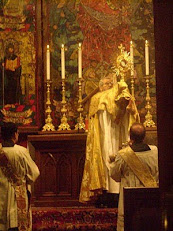Second Sunday of the Year
15 January 2012
Dear Friends in Christ,
In November 2009, Pope Benedict XVI promulgated an Apostolic Constitution entitled Anglicanorum coeitbus, meaning “Groups of Anglicans”. This document was given by the pope in response to numerous requests he had received over the years from Anglicans for a pastoral structure to be created that would allow them to be received into full communion with the Catholic Church as groups rather than as individuals, and in responding to their requests, Pope Benedict also provided a new pastoral structure in the Church called a “Personal Ordinariate” which is a bit like a non-territorial diocese. To provide pastoral care for the laity who will be organized into parishes in these Ordinariates, former Anglican bishops and priests can be ordained to the priesthood in the Catholic Church, with a dispensation from the norm of priestly celibacy, and much of the Anglican patrimony will be preserved in each Ordinariate, including their liturgy through an Anglican Use of the Roman Rite.
Since Pope Benedict published Anglicanorum coetibus, two Personal Ordinariates have been established. In January 2011, the Personal Ordinariate of Our Lady of Walsingham was created for England and Wales, and earlier this month, the Personal Ordinariate of the Chair of St. Peter was created for the United States. The priest who leads this new structure, Father Jeffrey Steenson, is a former bishop of the Episcopal Church who became a Catholic in 2007 and was ordained under the Pastoral Provision (like Father Longenecker) in 2009. Father Steenson has already received requests to join the Ordinariate from around 100 Anglican clergy and over 1,400 lay persons from around the United States. Two former parishes of the Episcopal Church have already been received into the Catholic Church as groups — one in Maryland and the other in Texas, and as this new structure expands, this will happen more often. In many cases, though, the first step is for an Anglican priest to become Catholic, and this we will witness here at St. Mary’s next week.
Father Jon Chalmers is a priest of the Episcopal Church (the main American branch of the Anglican Communion), and for the past two years he has been on the staff at Christ Church here in Greenville. On Sunday 22 January 2012 during the 11 am Mass, Jon Chalmers will be received into full communion with the Catholic Church and confirmed by Bishop Guglielmone, and the following week he will begin his formation for priestly ordination in the Catholic Church in Houston, Texas — the seat of the new Ordinariate. In the coming months, if sufficient numbers of Anglicans desire to be joined to the Ordinariate here in Greenville, Jon will be responsible for their pastoral care, and after his ordination as a Catholic priest, he will celebrate the Anglican Use liturgy as well as be available to assist local Roman Rite parishes.
To learn more about all of this, visit the website www.usordinariate.org.
Father Newman
Read theoriginal post on the parish home page.
Obituary of a very failed Pontificate
-
"Nun khre methusthen kai tina per bian ponen, epei de katthane
Mursilos."Such would have been the reaction of the unchristianised Greeks.
But for us, for t...
7 months ago














No comments:
Post a Comment